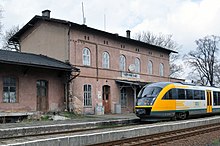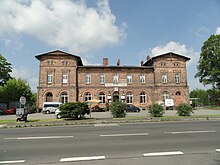Zittau – Hagenwerder railway line
| Zittau – Hagenwerder | |||||||||||||||||||||||||||||||||||||||||||||||||||||||||||||||||||||||||||||||||||||||||||||||||||||||||
|---|---|---|---|---|---|---|---|---|---|---|---|---|---|---|---|---|---|---|---|---|---|---|---|---|---|---|---|---|---|---|---|---|---|---|---|---|---|---|---|---|---|---|---|---|---|---|---|---|---|---|---|---|---|---|---|---|---|---|---|---|---|---|---|---|---|---|---|---|---|---|---|---|---|---|---|---|---|---|---|---|---|---|---|---|---|---|---|---|---|---|---|---|---|---|---|---|---|---|---|---|---|---|---|---|---|
|
Excerpt from the route map of Saxony 1902
| |||||||||||||||||||||||||||||||||||||||||||||||||||||||||||||||||||||||||||||||||||||||||||||||||||||||||
| Route number : | 6589; sä. ZN | ||||||||||||||||||||||||||||||||||||||||||||||||||||||||||||||||||||||||||||||||||||||||||||||||||||||||
| Course book section (DB) : | 220 | ||||||||||||||||||||||||||||||||||||||||||||||||||||||||||||||||||||||||||||||||||||||||||||||||||||||||
| Route length: | 23.605 km | ||||||||||||||||||||||||||||||||||||||||||||||||||||||||||||||||||||||||||||||||||||||||||||||||||||||||
| Gauge : | 1435 mm ( standard gauge ) | ||||||||||||||||||||||||||||||||||||||||||||||||||||||||||||||||||||||||||||||||||||||||||||||||||||||||
| Maximum slope : | 15.87 ‰ | ||||||||||||||||||||||||||||||||||||||||||||||||||||||||||||||||||||||||||||||||||||||||||||||||||||||||
| Minimum radius : | 330 m | ||||||||||||||||||||||||||||||||||||||||||||||||||||||||||||||||||||||||||||||||||||||||||||||||||||||||
| Top speed: | 80 km / h | ||||||||||||||||||||||||||||||||||||||||||||||||||||||||||||||||||||||||||||||||||||||||||||||||||||||||
|
|||||||||||||||||||||||||||||||||||||||||||||||||||||||||||||||||||||||||||||||||||||||||||||||||||||||||
The Zittau – Hagenwerder railway is a branch line in Saxony that was originally built and operated by the Berlin-Görlitzer Eisenbahn-Gesellschaft . It runs from Zittau along the Lusatian Neisse via Ostritz to Hagenwerder (until 1936: Nikrisch ), where it joins the former Görlitz – Seidenberg main line. Parts of the route have been on Polish territory since 1945 .
history
The first efforts to build a railway between Zittau in the Saxon part of Upper Lusatia and Görlitz in the Prussian part of Upper Lusatia since 1815 date back to 1860. In that year the city of Görlitz submitted a petition to the Prussian House of Representatives, and the Saxon government approved the To attain construction. In 1867 the Berlin-Görlitzer Eisenbahn also tried to get a concession to continue their line to Zittau, which the Prussian government refused.
Only in connection with the planned construction of the Görlitz – Seidenberg line of the Berlin-Görlitzer Eisenbahngesellschaft was a branch line to Zittau licensed on August 13, 1873. A state treaty between Saxony and Prussia regulated the conditions for construction and operation.
On June 1, 1875, the Görlitz – Seidenberg line went into operation, and the branch line to Zittau followed on October 15, 1875.
On May 1, 1882, management of the line was transferred from the Berlin-Görlitzer Railway to the Prussian State Railway . The final nationalization of the Berlin-Görlitz Railway followed on January 1, 1883.
When the insolvent Thuringian Weimar-Geraer Eisenbahn was up for sale in 1895 , Saxony renounced its acquisition in favor of Prussia. In return, Saxony was offered the Zittau – Nikrisch line on very favorable terms. The Saxon state parliament approved this barter, so that the Zittau – Nikrisch line passed into Saxon state ownership on April 1, 1896. In the Saxon route designation scheme, the route was henceforth led with the abbreviation ZN .
On June 15, 1924, the previous main line was downgraded to the branch line.
After the Sudetenland was annexed to Germany on October 1, 1938, the double-track expansion of the line began due to the expected increase in traffic, but was no longer completed because of the Second World War that began in 1939 . From November 2, 1938, the second track Abzw Eckartsberg – Hirschfelde was put into operation. On January 12, 1942, the short section from Zittau to Abzw Eckartsberg followed.
After the end of the Second World War, the areas east of the Lusatian Neisse came with part of the route to Poland . In 1948 the sections between kilometers 8.4 and 9.8 as well as 10.0 and 21.0 were transferred to the Polish State Railways (PKP). Since then, German train traffic has been operated in privileged through traffic .
First, freight traffic was resumed, and from 1948 passenger traffic on the German side as well, but the trains did not stop on the Polish section. From 1950 the trains stopped again in the station of Ostritz, which now bore the Polish name Krzewina Zgorzelecka . From there, it was possible to walk over a footbridge into Ostritz, Germany. The PKP built a connection to the line on their side in order to be able to better develop lignite deposits. A connection to the network was established at Ręczyn and a branch to Bogatynia just before the border at Hirschfelde. From then on, Polish freight and passenger trains ran on this route.
Since then, the kilometering of the route has been a special feature . From then on, the PKP integrated its section into the continuous kilometering of the Mikułowa – Bogatynia railway line , the short border sections Hirschfelde – Abzw Trzciniec Zgorzelecki and Abzw Ręczyn – Hagenwerder are also run as separate lines. The Deutsche Reichsbahn , on the other hand, continued to regard the Zittau – Hagenwerder route as a unit and thus retained the old kilometers from Zittau. This explains the two- kilometer jump at the state border at the former Rosenthal stop, where German departmental signs are placed on the 250 meters along the route on the western bank of the Neisse .
The Polish state railway PKP stopped passenger traffic on its section of the line in 2000. In terms of freight traffic, the route is still operated by the PKP; coal trains run from the Turów opencast mine . The Neisse bridge near Ostritz has also been in operation as a border crossing since 1995, so that the trains have also been available for Polish passengers since then. In 2006 the line was extensively renovated with EU and German funds.
During the Neisse floods on 7./8. August 2010 the line was flooded in several places. The Hirschfelde station was completely flooded. On the Polish section, train traffic could be resumed after a few days. Between Zittau and Görlitz, the line was closed for a long time due to severe damage between Hagenwerder and Görlitz. The train service was resumed on April 1, 2011 without restrictions.
Current operation
On the Neißetalbahn the trains of the Ostdeutsche Eisenbahn (ODEG) run every hour on the OE65 line, which replaced the Lausitzbahn on the Zittau – Cottbus route with the timetable change on December 14, 2008 . The travel times for the entire route are one hour and 51 or 54 minutes, for the Zittau – Görlitz section 35 and 38 minutes, respectively. Train crossings take place regularly in Hagenwerder. The Krzewina Zgorzelecka (Ostritz) station is now only used for non-scheduled train crossings.
future
According to the federal government's package of measures, the route is planned for electrification as part of the Görlitz – Zittau connection .
Route description
course
The line leaves Zittau station in a north-east direction. The route now leads almost in a straight line through meadows and fields to Hirschfelde. There the Neisse will be crossed for the first time in the course of the route and the track now runs over Polish territory. From the right, the PKP line from Bogatynia (Reichenau) , which is only used for goods traffic today, joins . On the following kilometers, the track leads through the narrow, scenic valley of the Neisse. At the former Rosenthal stop , the Neisse is crossed twice in a bend in the river, which leads to the curiosity that around 200 meters of the route there is still owned by DB Netz today . After the Krzewina Zgorzelecka station - formerly Ostritz station - the Polish line branches off to Zawidów (Seidenberg) and the Neisse is crossed a fourth time.
Operating points
Zittau
Zittau station was put into operation on June 10, 1848 by the Löbau-Zittau railway company as the end point of their line from Löbau. It has been expanded several times over the years. With the construction of the lines to Reichenberg (1859), Warnsdorf (1871), Nikrisch (1873), Reichenau (1884) and Oybin / Jonsdorf (1890), it became the largest railway junction in southern Upper Lusatia.
Eckartsberg junction
The Eckartsberg junction was a junction at the beginning of the double-track section to Hirschfelde. It only existed from November 2, 1938 to January 12, 1942.
Rohnau
The Rohnau stop was built in 1882 near the village of the same name, Rohnau, east of the Neisse. A bridge south of the station led to the massive service building and the wooden waiting hall. After the opening of the pedestrian bridge over the Neisse to Rosenthal , numerous Rosenthal residents used the Rohnau stop because it was closer to the town. After the Second World War, the halt was looted and visibly fell into disrepair. The station is hardly recognizable today.
Rosenthal
The Rosenthal stop was set up in 1884 near Otto Raspe's popular excursion restaurant in the Neisseeng Valley. After its closure around 1940, the breakpoint was opened again on November 1, 1943. The former stopping point is now on the German section, which is only about 200 meters long, with which the route shortens a loop of the Neisse and thus crosses the border twice.
Bratków Zgorzelecki
The Bratków Zgorzelecki stop (until 1945: Marienthal (Sachs)) was abandoned in 2000.
Hagenwerder
Hagenwerder station (until 1936: Nikrisch) has existed on the Görlitz – Seidenberg line on July 1, 1875. During the GDR era, the station handled extensive transports for the construction and operation of the nearby Hagenwerder power station .
See also
literature
- Wilfried Rettig: Railway in the three-country corner, part 1 . EK-Verlag Freiburg, 2010, ISBN 978-3-88255-732-9 .
- Reiner Preuss: Saxon State Railways . transpress Verlagsgesellschaft mbH, Berlin 1991, ISBN 3-344-70700-0 .
- Bernd Kuhlmann: Railways across the Oder-Neisse border . Ritzau KG - Zeit und Eisenbahn Verlag, Pürgen 2004, ISBN 3-935101-06-6 .
Web links
- Website for the Neißetalbahn ( memento from February 11, 2013 in the web archive archive.today )
- Photos and information from the Neißetalbahn
- ODEG homepage
Individual evidence
- ↑ Timetable for line OE65, valid from August 28, 2015, online at www.odeg.de (PDF file, approx. 107 kB)
- ↑ The coal exit billions are to flow into these projects , rbb24 of April 4, 2020, accessed on April 8, 2020
- ^ Wilfried Rettig: Railway in the three-country corner. East Saxony (D) / Lower Silesia / (PL) / North Bohemia (CZ). Part 1: History of the main lines, operating points, electrification and route descriptions . EK-Verlag, Freiburg (Breisgau) 2010, ISBN 978-3-88255-732-9 , p. 163 f .








